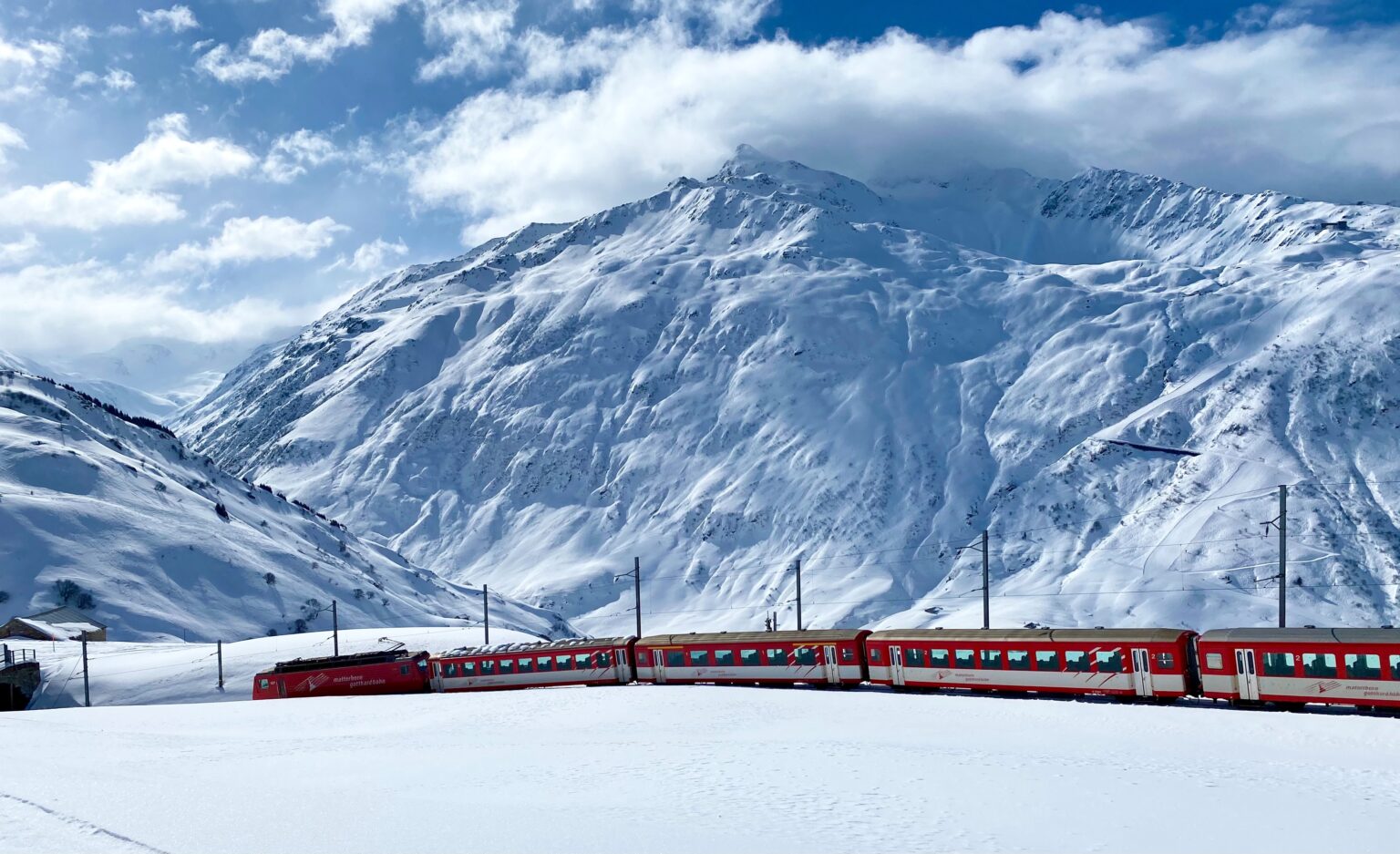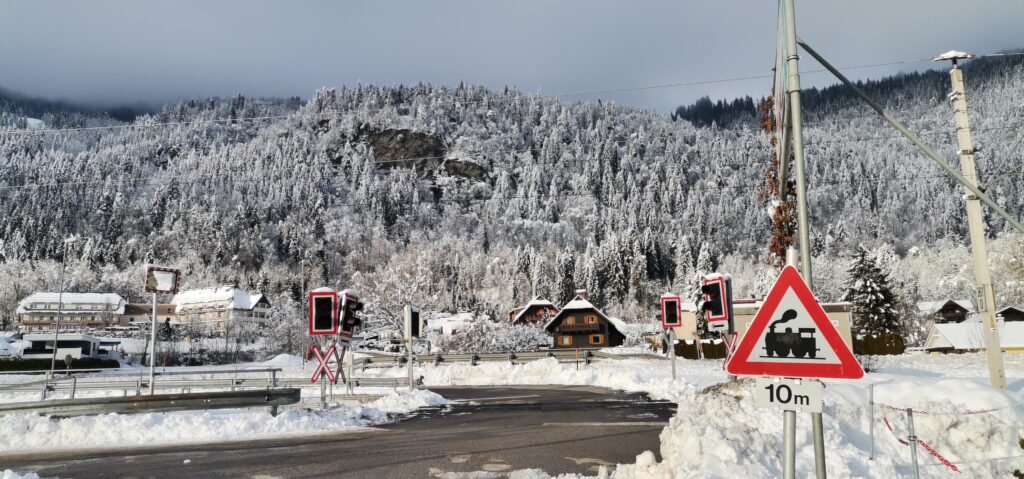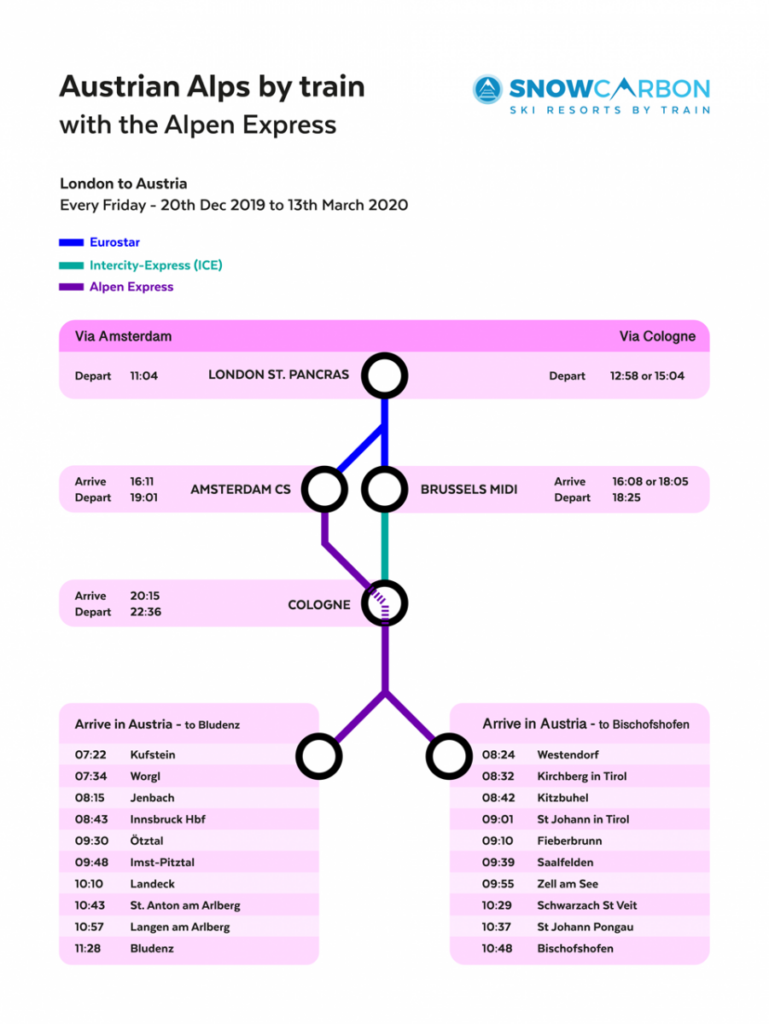Alps by Train
Cut the CO2 emissions of your next ski adventure and travel by rail


The transport sector is Europe’s second largest emitter of greenhouse gases, contributing more than a quarter of all emissions on the continent. Within the tourism sector, transport accounts for 75% of the global emissions, of this 40% is attributable to air travel. Transport is therefore a key driver of climate change; raising temperature, shortening winters and reducing snowfall. As the outdoor community we see the impact of these changes through melting glaciers, increasing rockfall and smaller snowpacks.
Protect Our Winters POW
It’s the transport that we as skiers take to and from the mountains that has the biggest impact on the climate. Often the cheapest travel option emits most CO2. Flights are far often cheaper than taking the train, and as long as it remains the cheapest mode of transport, change is hard to make when it comes to reducing our footprint.
Driving a car is currently the most carbon intensive form of land transport, but is also the most popular choice, reports POW. Under-occupancy of cars increases the problem with an empty car (go figure) creating four-times the impact of a full one. But the average car occupancy is 1.5 people. A full bus can replace around 40 cars, but buses are often inconvenient and limit luggage. When it comes to motorised passenger transport, trains are the most environmentally friendly way of travelling, and in Europe 75% of the rail network uses electric trains. Electric trains have zero emissions at the point of use, benefitting local air quality, and generally emit around 30% less carbon per passenger mile than a diesel train. Greener and cheaper to run, they’re also lighter – meaning less track wear and tear, and so maintenance.
Our all-round best option, and with great connections to hundreds of ski resorts across Europe, we look here at how and where we can take the train this season in order to ski a little greener.

London – French Alps
Rail travel generates around 5% of the CO2 emissions per passenger mile compared to the same trip by air. It’s a more comfortable way to travel and can offer a much smoother journey. The drawback is that these days, all direct routes from the UK have been taken over by tour operators. It means that if you want a change-free journey, you have to buy a package ski trip that includes travel, accommodation (and often a lift pass). Although this can put limits on where you go and for how long, there are some great options out there.
French tour operator Travelski has monopoly of the direct ski train from the UK (London St Pancras) to the heart of the French Alps. Previously the Eurostar ski train, it lands at Moûtiers, Aime-la-Plagne and Bourg-St-Maurice, giving access to dozens of ski resorts nearby.
Travelski’s list of resorts includes Val d’Isère, Tignes, Les Arcs, La Plagne, Brides Les Bains, Les Menuires, Meribel, Val Thorens, Courchevel and La Rosiere.
But if you want to visit one of many many other ski resorts in the region, an independently booked ski trip and an indirect train route is the alternative (more below).
Amsterdam – Austrian Alps
Similarly, a train from Amsterdam to the Austrian Alps has been comandeered by TUI’s Dutch division. This new service is an option for British skiers looking to book a package ski trip with TUI and travel to Amsterdam independently by Eurostar (four hours).
Positives | Timings are good. The TUI ski express leaves Amsterdam at 5.30pm, dropping skiers in the Austrian Alps on Saturday morning. It also only means a platform change in Amsterdam, rather than a station change in Paris – much less of faff when lugging skis (or kids).
Negatives | This would be taking the very long road. If Austria is the destination, then via Brussels and Cologne would be a more direct route. Plus, buying a separate Eurostar ticket on top of your all-in deal slightly defeats the point of a package holiday, and is no small extra cost.
Brussels – French Alps
Plans of a new sleeper rail service from Brussels to the French Alps – a collaboration between Sunweb and European Sleeper – were announced in summer 2022, but no bookings have been made available yet.
Organising a train to your mountain resort is a journey of three parts. It sounds stressful – as does organising it – but try it once and you’ll likely do it again.
First step | Eurostar at St Pancras over to Paris – Nord.
Next | Getting from Paris – Nord over to Paris – Lyon. Gare du Lyon is where TGVs bound for the Alps depart. Options are a 20-minute taxi, if you’re lucky with traffic. There’s a taxi rank 50 metres from the Eurostar platform. Or using the RER line D – part of Paris’ metro system – a swift seven minutes between stations, once you’ve found the platform, in the direction of Melun or Malesherbes. Trains run every six minutes during peak times (every 11 minutes on Sundays). Buy tickets (€2) for the RER from the cafe-bar on the Eurostar or TGV trains to avoid queues in the station.
Allow 45 minutes total for your transfer from Paris Nord to Paris Lyon.
From Paris Gare de Lyon, travel opens up to all corners of the Alps. Check out Trainline.eu for destinations in Switzerland, France and Austria for starters.
If traveling to Verbier, for example, a train from Paris to Geneva (on to Martigny) will be your access. Paris to Lausanne or Zurich – Switzerland’s rail hubs – are both around a four-hour journey and are your gateway to Switzerland’s famous ski regions. The beauty of travelling by Swiss rail goes beyond the landscape you’ll travel through; there’s never a slog between platforms if changing train and there’s never a wait – the train timetables are organised to perfection.
Although training it to the French and Swiss Alps is most popular, Italy’s skiing is also pretty easily accessed from Paris. Oulx is a good option. Five hours from Paris by train (stopping at Lyon and Chambéry along the way), it’s part of the Milky Way ski area that borders France. Ski resorts within easy reach are Cesana-Sansicario, Claviere, Pragelato, Sauze D’Oulx, Sestriere and Montgenèvre (the French corner of the ski area) as well as Serre Chevalier just a little further into France.
A SNCF night train connects Paris to Briançon in the Southern Alps, with its own skiing and also linking to the extensive Serre Chevalier lift system.
Bardonecchia in Italy’s Piedmont is easy to reach by train from Paris, in less than five hours with no changes.
Travelling to Milan opens up yet another ski region, and a high speed train to Tirano (2 hrs 30) gives the closest access to Livigno – a resort notoriously long to get to. Tirano is the starting point for the Bernina Express, the world’s steepest train route towards St Moritz via an arcadia of alpine landscape.
London to Innsbruck – with its many, many surrounding ski resorts – by hauptbahnhof is longer. The fastest services are over 11 hours and two changes are needed, though on average it takes more like 14 hours and a night/sleeper train is best. Prices can be very good, though, starting from £82 if booking in advance:
Austria by sleeper train
Eurostar to Brussels – Ice/Thalys to Cologne, OBB NightJet or Alpen Express to the Austrian Tirol.
It’s a three-legged journey that can allow two extra days on the slopes. After the swift Eurostar lands you at Brussels-midi station, you only have to change platforms to jump on the train to Cologne, Germany. The trains are comfortable and spacious and have huge windows. From Cologne, sleeper trains take you to either the Tirol, or to Salzburg – city ski hubs. There are hundreds of ski resorts to choose from.
The Alpen Express sleeper lets you choose from sleeping in a two-berth, four-berth or six-berth couchette compartment. These can be shared or booked as private.

London to Austria via Alpen Express — via Amsterdam:
1. Eurostar from London to Amsterdam
2. Have a big tea in Amsterdam
3. Alpen Express sleeper train from Amsterdam to Austrian ski resorts
London to Austria via Alpen Express — via Brussels and Cologne:
1. Eurostar from London to Brussels
2. ICE or Thalys from Brussels to Cologne
3. Dinner in Cologne, at or near the station
4. Alpen Express sleeper train from Cologne to Austrian ski resorts
Many of the station stops are in ski resort villages themselves. Kitzbühel has a train station bang in the centre of town, as does St Anton am Arlberg and Zell am See – Kaprun. Söll is another good one for skiers adventuring by train, where a local bus takes 20 minutes to resort from Kufstein station, between Salzburg and Innsbruck.
Use rail company and ticketing websites such as Loco2, Trainline.eu, Deutcshe Bahn, OBB or SBB to research and compare journey schedules.
Issues with trains might include high prices and difficulties with tickets when it comes to using multiple rail companies. On the plus side, you can skip baggage fees as well as crowded airports, and feel a helluva lot better about your winter ski trip. Ski green everyone!
Snowcarbon website is a great resource for planning your winter holiday to the Alps. Info includes more routes and journey planning, as well as what do do in the case of delays or cancelled trains, and tips on how to book the lowest fares.